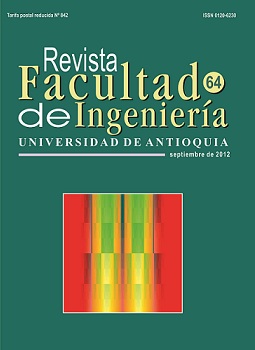An empirical investigation on the impacts of spatial and temporal aggregation on empty trips models
DOI:
https://doi.org/10.17533/udea.redin.13123Keywords:
freight transportation, empty trip models, stability of parametersAbstract
This paper analyzes the impacts of spatial and temporal aggregation of empty trips models. The authors analyze five models of empty trips (Noortman and van Es, and four Holguin-Veras and Thorson empty trips models) for different aggregation levels of six national freight origin-destination (OD) matrices. They were collected by Colombiaís Ministry of Transportation during the 2000 to 2005 time period. The research includes an assessment of the spatial aggregation and time-dependency of the parameters for the different models. Furthermore, three aggregation levels are examined to study the performance of the different empty trips models specifications and the spatial and temporal stability of the parameters for these models.
Downloads
References
K. Ogden. Urban goods movement: a guide to policy and planning. Brookfield: Ashgate Publishing Company. Cambridge, Great Britain. 1992. pp. 397.
J. Holguín-, E. Thorson. “An investigation of the relationships between the trip length distributions in commodity-based and trip-based freight demand modeling,” Transportation Research Record. Vol. 1707. 2000. pp. 37-48. DOI: https://doi.org/10.3141/1707-05
J. Holguín, E. Thorson, “Modeling commercial vehicle empty trips with a Æ rst order trip chain model,” Transportation Research Part B: Methodological. Vol. 37. 2003. pp. 129-148. DOI: https://doi.org/10.1016/S0191-2615(01)00048-0
J. Holguin , A framework for an integrative freight market simulation. in IEEE 3rd Annual Intelligent Transportation Systems Conference ITSC-2000. Dearborn, Michigan. 2000. pp. 476-481.
U. Censu s, “Vehicle Inventory and Use Survey”. Washington, D. C. United States. 2004. pp. 66.
A. Strauss , K. Kang, M. Yokei, The Truck Commodity Survey in the New York-New Jersey Metropolitan Area, in Good Transportation in Urban Areas, Proceedings of the 5th Conference, Santa Barbara, CA. 1989. pp. 83-94.
J. Holguin, I. Sanchez, C. Gonzalez, I. Sarmiento, E. Thorson, “Time-Dependent Effects on Parameters of Freight Demand Models: An Empirical Investigation,” in Journal of Transportation Research Board. Vol. 2224. 2011. pp. 42-50. DOI: https://doi.org/10.3141/2224-06
J. Holguín, E. Thorson, “Practical implications of modeling commercial vehicle empty trips”. Journal of the Transportation Research Board. Vol. 1833. pp. 87- 94, 2003. DOI: https://doi.org/10.3141/1833-12
J. HolguÌn, E. Thorson, J. Zorrilla, “Commercial Vehicle Empty Trip Models with Variable Zero Order Empty Trip Probabilities”. Networks and Spatial Economics. Vol. 10. 2008. pp. 241-259. DOI: https://doi.org/10.1007/s11067-008-9066-7
H. Hautzinger, The Prediction of Interregional Goods Vehicle Flows: Some Modeling Concepts, in Ninth International Symposium on Transportation and Traffic Flow Theory. Delft, The Netherlands. 1984. pp. 375-396.
H. Noortman, J. van Es. Traffic Model. Manuscript for the Dutch Freight Transport Model. Amsterdam, The Netherlands. 1978.
Ministerio de Transporte. “Encuesta de origen-destino a vehículos de carga 1999î. Grupo de Estudios de Carga. Ministerio de Transporte. Bogotá, Colombia. 2001. pp. 76.
J. Holguín, J. Zorrilla, E. Thorson. Modeling commercial vehicle empty trips: theory and application. In XVI International Symposium of Traffic and Transportation Theory (ISTTT). Ed. H. Mahmassani, ed: Elsevier, 2005. pp. 585-608. DOI: https://doi.org/10.1016/B978-008044680-6/50032-5
A. Jiménez, Calibración de un modelo para estimar los viajes de carga vacÌos-caso colombiano, M.S., Univeridad Nacional de Colombia Sede MedellÌn. MedellÌn, Colombia. 2009. pp. 83-94.
Downloads
Published
How to Cite
Issue
Section
License
Copyright (c) 2018 Revista Facultad de Ingeniería

This work is licensed under a Creative Commons Attribution-NonCommercial-ShareAlike 4.0 International License.
Revista Facultad de Ingeniería, Universidad de Antioquia is licensed under the Creative Commons Attribution BY-NC-SA 4.0 license. https://creativecommons.org/licenses/by-nc-sa/4.0/deed.en
You are free to:
Share — copy and redistribute the material in any medium or format
Adapt — remix, transform, and build upon the material
Under the following terms:
Attribution — You must give appropriate credit, provide a link to the license, and indicate if changes were made. You may do so in any reasonable manner, but not in any way that suggests the licensor endorses you or your use.
NonCommercial — You may not use the material for commercial purposes.
ShareAlike — If you remix, transform, or build upon the material, you must distribute your contributions under the same license as the original.
The material published in the journal can be distributed, copied and exhibited by third parties if the respective credits are given to the journal. No commercial benefit can be obtained and derivative works must be under the same license terms as the original work.










 Twitter
Twitter